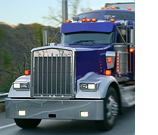Insights
 Shifting Risks in Commercial Transportation
Shifting Risks in Commercial Transportation
July 15, 2025
The commercial transportation industry is grappling with a rapidly changing risk climate. Once focused primarily on physical perils such as accidents, cargo loss, and environmental hazards, today’s transportation businesses face emerging liabilities tied to workforce dynamics, economic pressures, and geopolitical uncertainty.
In this article, we explore four key risk exposures — and adaptable risk management tactics — related to labor shortages, inflation, tariffs, and an evolving workforce demographic. To learn more about insurance coverage for transportation businesses across industry classes, visit our Transportation page.
Primary Transportation Risks
Evolving risk profiles are no strangers to the transportation sector. It can be beneficial to evaluate emerging risks and industry trends, including the four following primary risks.
Labor Shortages and Related Liabilities
Labor shortages continue to plague the commercial transportation sector, especially among truck drivers, warehouse workers, and mechanics. This staffing shortfall exposes companies to several risks, including:
- Driver fatigue and safety concerns: Fewer available workers often leads to longer shifts, increasing the risk of accidents, injuries, and subsequent liability claims.
- Compliance violations: Overburdened staff may inadvertently (or intentionally) violate hours-of-service regulations, opening the door to fines, penalties, and lawsuits.
- Negligent hiring and retention: In the rush to fill vacancies, businesses may relax hiring standards or fail to conduct proper background checks, potentially leading to claims if an unqualified employee causes harm.
Transportation companies can invest in workforce retention programs, such as offering competitive pay, flexible schedules, and wellness initiatives that reduce burnout. Strengthening hiring practices — including thorough background checks and pre-employment screenings — can reduce negligent hiring exposure. Leveraging technology like electronic logging devices (ELDs) ensures compliance with hours-of-service rules and can serve as evidence in defending claims.
Inflation and Its Impact on Liability Exposure
Inflation has significantly raised the cost of materials, vehicle parts, fuel, and insurance premiums. The legal implications for transportation firms include:
- Higher claim costs: The price of vehicle repairs, cargo replacement, and medical care following accidents has increased, leading to larger liability settlements and judgments.
- Contractual risks: Fixed-rate contracts may not account for escalating costs, resulting in disputes with customers or vendors over service delivery or pricing.
- Inadequate coverage: Rising costs may outpace existing liability policy limits, leaving companies underinsured in the event of a major claim.
It’s wise top regularly review and update insurance policies to ensure limits reflect current replacement and liability costs, and to build inflation-adjustment clauses or fuel surcharges into contracts where possible to mitigate disputes. Additionally, explore higher-deductible policies paired with captive insurance or risk retention groups to balance premium costs against protection needs.
Tariff Uncertainty and Contractual Liabilities
Shifting U.S. trade policies and the threat of new tariffs on vehicles, parts, and transported goods create contractual and operational risks like these:
- Breach of contract claims: Unanticipated costs due to tariffs may make it difficult to honor shipping rates or delivery schedules, leading to legal disputes.
- Cargo value discrepancies: Tariff-related price swings can increase the financial exposure tied to cargo loss or damage, especially when liability limits are based on outdated valuations.
- Cross-border complexities: Companies involved in international transport may face legal and compliance challenges as trade rules evolve.
If possible, incorporate tariff contingency clauses into contracts to provide flexibility for price adjustments or alternative supply routes; work with legal counsel to ensure cross-border agreements align with current trade regulations; and review cargo insurance policies regularly to confirm that declared values and limits are accurate given shifting market prices.
Changing Workforce Demographics
The transportation labor force is evolving, with more younger workers, immigrants, and underrepresented groups entering the industry. These demographic shifts create both opportunities and challenges such as:
- Training and communication risks: A more diverse workforce may necessitate updated safety training programs and multilingual materials to ensure comprehension and regulatory compliance.
- Workplace discrimination claims: Employers may face greater exposure to claims of harassment, discrimination, or failure to accommodate under state and federal laws.
- Cultural competency gaps: Supervisors may require additional training to manage and support a diverse team effectively, reducing the risk of internal disputes and liability.
Companies can implement comprehensive onboarding and safety training programs that accommodate language and cultural differences. It is a good practice to maintain clear anti-harassment and anti-discrimination policies and create accessible reporting channels to address workplace concerns early.
Protecting Transportation Assets with Insurance
Working with an experienced transportation insurance broker or underwriter is essential in today’s complex and evolving risk environment. These professionals understand the unique exposures facing commercial transportation businesses — from labor-related liabilities and contractual risks to inflation-driven cost increases and regulatory uncertainties.
An expert broker can help tailor coverage that fits the specific operations of a transportation company, including auto liability, cargo insurance, general liability, workers’ compensation, employment practices liability, and excess/umbrella policies.
Just as importantly, they can assist in negotiating contract terms, implementing risk mitigation strategies, and navigating claims efficiently, helping transportation companies protect their assets and maintain resilience in a challenging market. ◼

